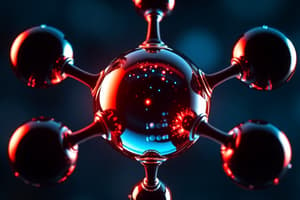Podcast
Questions and Answers
What shape do the orbitals in a water molecule adopt?
What shape do the orbitals in a water molecule adopt?
- Square
- Triangular
- Tetrahedral (correct)
- Linear
Water molecules have equal sharing of bonding electrons.
Water molecules have equal sharing of bonding electrons.
False (B)
What is the main reason for water's polar nature?
What is the main reason for water's polar nature?
Unequal sharing of electrons due to the difference in electronegativity between oxygen and hydrogen.
A water molecule can form hydrogen bonds with up to ______ other water molecules.
A water molecule can form hydrogen bonds with up to ______ other water molecules.
Match the following components of a water molecule:
Match the following components of a water molecule:
Which of the following statements about hydrogen bonds is true?
Which of the following statements about hydrogen bonds is true?
Oxygen is less able to attract electrons than hydrogen.
Oxygen is less able to attract electrons than hydrogen.
What charges do hydrogen and oxygen atoms have in a water molecule?
What charges do hydrogen and oxygen atoms have in a water molecule?
What primarily causes hydrogen bonding between water molecules?
What primarily causes hydrogen bonding between water molecules?
Hydrogen bonds are significantly strong compared to covalent bonds.
Hydrogen bonds are significantly strong compared to covalent bonds.
What are amino acids primarily known as?
What are amino acids primarily known as?
Liquid water's dynamic structure allows water molecules to _____ and re-establish hydrogen bonds.
Liquid water's dynamic structure allows water molecules to _____ and re-establish hydrogen bonds.
Which of the following elements is NOT involved in hydrogen bonding with hydrogen?
Which of the following elements is NOT involved in hydrogen bonding with hydrogen?
Match the following terms related to water's properties:
Match the following terms related to water's properties:
Hydrogen bonds play a role in maintaining the structural stability of proteins.
Hydrogen bonds play a role in maintaining the structural stability of proteins.
Name one type of plant that can transport water through narrow columns using cohesive forces.
Name one type of plant that can transport water through narrow columns using cohesive forces.
Flashcards are hidden until you start studying
Study Notes
Structure of Water Molecule
- Water molecule is formed by one oxygen atom and two hydrogen atoms.
- Orbitals in water arrange in a tetrahedral shape, directed toward the corners of a tetrahedron.
- Polar covalent bonds exist due to unequal sharing of electrons, resulting in regions of partial positive and negative charges.
Electronegativity
- Oxygen has higher electronegativity than hydrogen, able to attract electrons more effectively.
- Bonding electrons are localized around the oxygen atom, creating a negatively charged region, while hydrogen atoms exhibit small positive charges.
Polarity of Water
- Water is classified as a polar molecule due to its distinct charge separation.
- The presence of partial charges has significant implications for water's physical and chemical properties.
Hydrogen Bonding
- Hydrogen bonds form between the positively charged regions of one water molecule and the negatively charged regions of another, leading to the cohesive properties of water.
- Each water molecule can form hydrogen bonds with up to four other molecules.
- Hydrogen bonds are relatively weak, about one-tenth the strength of covalent bonds, but collectively contribute to water’s properties.
Temperature Effects on Hydrogen Bonds
- The extent of hydrogen bonding is affected by temperature; warmer temperatures can weaken these bonds as water molecules move more vigorously.
Properties of Water
- Water's dynamic structure allows molecules to continually break and reform hydrogen bonds, contributing to its cohesive strength.
- Cohesion leads to phenomena such as surface tension, enabling water to travel in narrow columns (e.g., through the xylem of tall plants).
Ionization of Water
- Water can ionize, producing hydroxide ions (OH-) and hydrogen ions (H+), contributing to its role in various biochemical processes.
- Hydrogen bonds also play a role in the structural stability of proteins, where amino acids bond via hydrogen interactions.
Biological Significance
- The ability of water to form hydrogen bonds with other substances is crucial for various biological functions, including nutrient transport and temperature regulation in living organisms.
Studying That Suits You
Use AI to generate personalized quizzes and flashcards to suit your learning preferences.




